
Calandrinia is a large genus of flowering plants known as purslanes and redmaids. It includes over 100 species of annual and perennial herbs which bear colorful flowers in shades of red to purple and white. Plants of this genus are native to Australia, western South America, Central America, and western North America. Some species have been introduced to parts of New Zealand, southern Africa, Asia, and Europe.
Beefwood is the name given to a number of Australian trees which have timber with a red colouration resembling raw beef as follows:
Pink purslane is a common name for several flowering plants, including:

The rock parrot is a species of grass parrot native to Australia. Described by John Gould in 1841, it is a small parrot 22–24 cm long and weighing 50–60 g with predominantly olive-brown upperparts and more yellowish underparts. Its head is olive with light blue forecheeks and lores, and a dark blue frontal band line across the crown with lighter blue above and below. The sexes are similar in appearance, although the female tends to have a duller frontal band and less blue on the face. The female's call also tends to be far louder and more shrill than the male's. Two subspecies are currently recognised.
Eagle Island is about 200 metres from Eagle Bluff on the Peron Peninsula in Shark Bay World Heritage Site in the Gascoyne region of Western Australia.

Alexander Morrison was a Scottish Botanist who was the first Government Botanist of Western Australia.
Heptapleurum calyptratum, commonly known as mallet flower, is a species of plant in the family Araliaceae. It is a scrambling tree that ranges from eastern India and Bangladesh through Tibet and Indochina to southern China.

Barringtonia calyptrata is a species of mangrove belonging to the family Lecythidaceae. It is native to New Guinea and to northern Queensland.
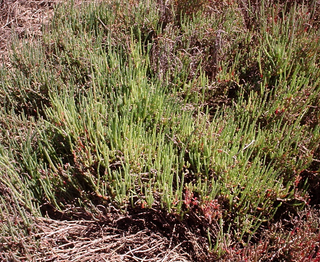
Tecticornia is a genus of succulent, salt tolerant plants largely endemic to Australia. Taxa in the genus are commonly referred to as samphires. In 2007, the genus Halosarcia, along with three other Australian genera was incorporated into the genus.
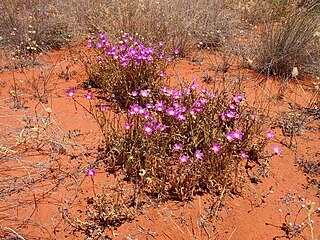
Rumicastrum balonense, synonym Calandrinia balonensis, is a succulent plant native to arid and semi-arid regions of Australia.

Eucalyptus salmonophloia, commonly known as salmon gum, wurak or weerluk or woonert or marrlinja. is a species of small to medium-sized tree that is endemic to Western Australia. It has smooth bark, narrow lance-shaped to curved adult leaves, flower buds in groups of between nine and thirteen, creamy white flowers and hemispherical fruit.
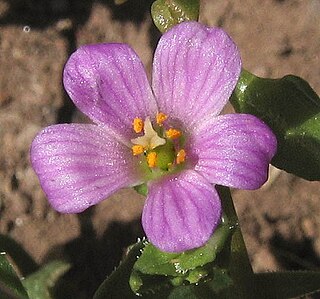
Calandrinia breweri is a species of flowering plant in the family Montiaceae known by the common name Brewer's redmaids.
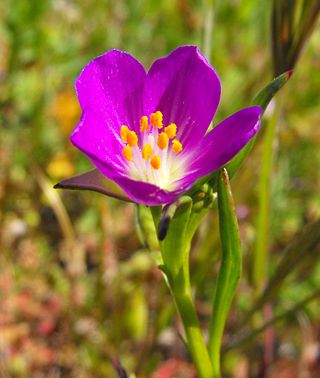
Calandrinia ciliata is a species of flowering plant known as fringed redmaids and red-maids. While formerly included in the Purslane family, it is now treated as a member of the family Montiaceae.

Podalyria calyptrata is a small, resilient, fast-growing tree of the Fabaceae (legume) family. It has velvety silver leaves, bears masses of bright-pink, sweetly scented flowers, and is indigenous to the Western Cape, South Africa.
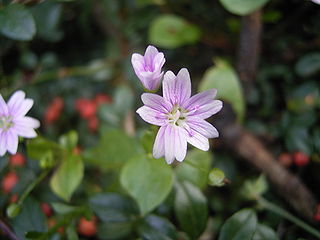
Montiaceae are a family of flowering plants, comprising about 14 genera with about 230 known species, ranging from small herbaceous plants to shrubs. The family has a cosmopolitan distribution.

Hippeastrum calyptratum is a flowering perennial herbaceous bulbous plant, in the family Amaryllidaceae, native to Brazil.

Omphalissa is an unaccepted subgenus of genus Hippeastrum, within the family Amaryllidaceae. Originally described by Richard Anthony Salisbury in 1866.

Rumicastrum corrigioloides is an annual herb in the family Montiaceae, and is native to Western Australia, South Australia, and Victoria.

Rumicastrum granuliferum is an annual herb in the family Montiaceae, and is native to New South Wales, Tasmania, Western Australia, South Australia, and Victoria.

Rumicastrum is a genus of plants in the family Montiaceae. It includes 66 species native to Australia, Tasmania, and New Guinea. These species were formerly classed in genus Calandrinia, which was discovered to be paraphyletic.
















